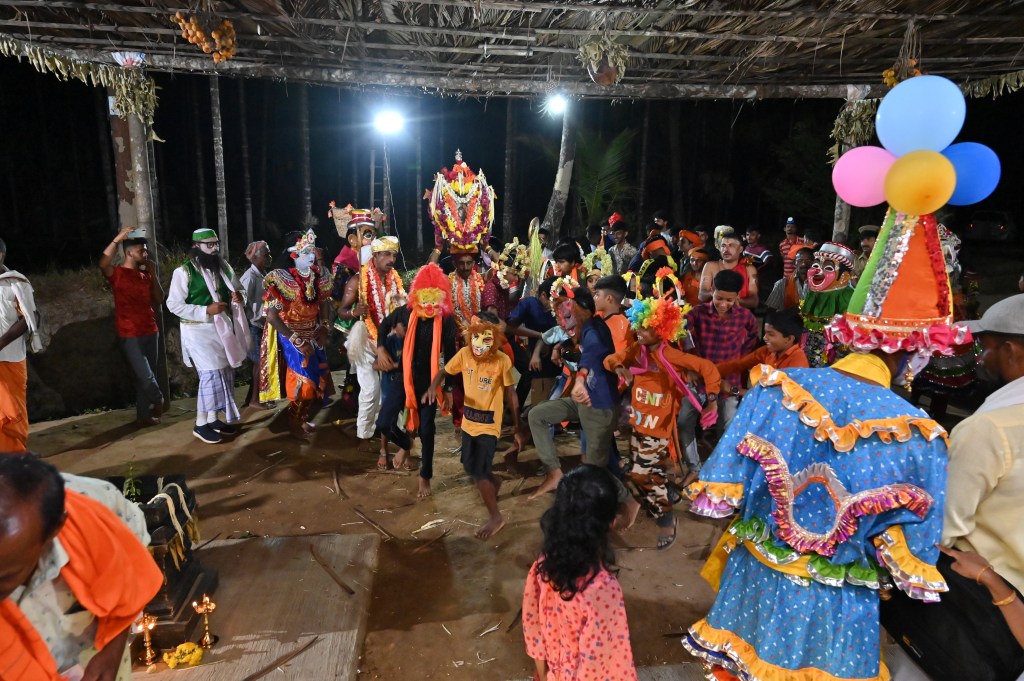Coastal Karnataka’s cultural tapestry, known as Tulunadu, is rich with oral traditions and folk dances that reflect the life and culture of the region. However, due to rapid urbanization and increasing literacy rates, some of these traditions are fading away and need dedicated efforts towards preservation. This article explores the invaluable cultural heritage of Pursa Kattuna, a traditional Tulu ritual dance, and the efforts of the Karavali Wikimedians to document it.
A Tulu ritual dance Pursa Kattuna is a traditional dance performed by Tulu-speaking individuals from various castes in Belthangady taluk in the Dakshina Kannada district. This ritual marks the culmination of agricultural activities and is predominantly done by men. It spans three to five nights, coinciding with the full moon period of the Tulu Calender’s Suggi month.
Led by the Gowda community, Pursa Kattuna fosters unity among participants of different castes, featuring distinctive costumes and aims to bring down the socio-economic divide in society and bring everyone together through dance.

The Importance of Documenting Our Living Heritage
The journey of documenting Pursa Kattuna revealed a profound cultural tapestry in Tulunadu villages, showcasing a wealth of traditions, rituals, and practices passed down through generations. These rituals are not just performances; they embody the community’s identity and history.
Tulunadu villages are repositories of living heritages, encompassing a rich tapestry of customs, traditions, rituals, and practices that continue to connect the present generation with their roots and history. Encouragement plays a crucial role, motivating village residents and performers to take pride in their cultural practices and pass them down to the next generation.
Documenting Pursa Kattuna and exploring living heritages provided valuable insights into various aspects of documentary production, including event management, public engagement, interviewing techniques, content planning, scriptwriting, camera techniques and budget management. These lessons will inform future documentary endeavors.
In conclusion, the documentation of Pursa Kattuna and the exploration of living heritages in Tulunadu villages showcase the cultural richness within these communities. This endeavor underscores the importance of preserving and promoting these traditions to ensure their legacy for future generations.
The Pursa Kattuna Documentary Project

The initiative to document Pursa Kattuna emerged from the realization that the folklore and traditions of Tulunadu needed focused preservation efforts. Hence, members of the Karavali Wikimedians Group Vishwanatha Badikana, Bharathesha Aalasandemajalu and Kishore Kumar Rai, embarked on a mission to document Tulu culture’s various rituals despite limited resources. Using cameras, they captured some of these unique traditions, highlighting the significant underrepresentation of Pursa Kattuna in Tulunadu’s cultural landscape in 2018.
The project gained momentum in 2022 with the support of South Asian WMF Staff, who assisted in crafting a proposal and conducting a pre-documentary survey and Dr. Aarya Joshi, a Marathi Wikimedian from Pune, Yakshitha Moodukonaje and Chidananda Kampa Tulu Wikimedians joined the team, providing guidance in various aspects. The documentary team, along with the director of the documentary, Dr. Sundara Kenaje, visited over 7 villages and engaged with 15 teams from different parts of Belthangady Taluk to understand the ritual and build trust within the local communities.
Key Highlights
Scholars believe Pursa Kattuna might have evolved under the influence of secret tantric sects during medieval Karnataka, adding mystique to its history. The documentary on Pursa Kattuna, presented in Tulu, is one of the first research-oriented explorations of this subject. It includes scholarly discussions, artist interviews, and insights from folklorists and experts, and runs for 39 minutes and 56 seconds. It also compares Pursa Kattuna with related dance forms like Arebhashe Siddavesha, Marati Naikas Bale Santu and Malekudiyara Siddavesha.
The Significance of the Documentary
The Pursa Kattuna documentary is a valuable resource for researchers, scholars, and enthusiasts interested in the rich cultural heritage of Pursa Kattuna and related dance forms, facilitating comprehensive studies in the domain of living and intangible heritage.
The project faced significant challenges, primarily due to the remote location of Belthangady beneath the Western Ghats, resulting in connectivity and accessibility issues; additionally, the villagers mostly engage in agriculture and animal husbandry, making it hard to find free days for discussions and documentation. The secrecy and deep faith surrounding the dance added complexity, with villagers hesitant to reveal the intricacies, fearing misinterpretation or harm to their customs.
Despite these challenges, the Pursa Kattuna documentary project persevered, demonstrating the power of community collaboration and the importance of preserving cultural heritage for future generations.
Take a look
- At the documentary on YouTube or Wikimedia Commons
- Wikimedia Commons category Pursa Kattuna and documentary brief report

Can you help us translate this article?
In order for this article to reach as many people as possible we would like your help. Can you translate this article to get the message out?
Start translation